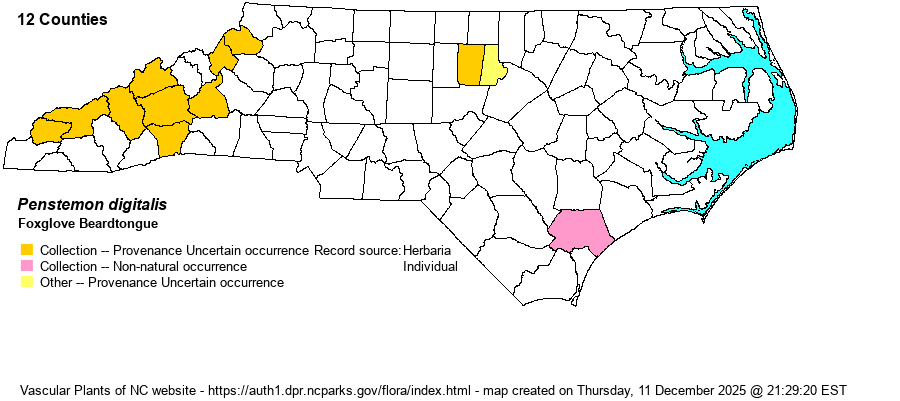| Author | Nuttall ex Sims | |
| Distribution | Scattered over the Mountains, but of uncertain provenance. Weakley's (2024) map considers this species to be uncertain provenance for NC, VA, TN, and most other Eastern states, native farther west. The website editors have thus considered the specimen records for the Mountains and the northern/western Piedmont as Uncertain Provenance, but those from far downstate to likely be Not Natural. The iNaturalist website contains numerous photos of the species across the Mountains and Piedmont, and sparingly in the Coastal Plain -- if most are correct. The editors choose not to add county records based on that website owing to not knowing if from planted locales or not.
This species is native mostly to the north and west of NC, ranging from eastern Canada and MN south to central VA, and then southwest to AL and eastern TX. | |
| Abundance | Rare in the central Mountains and adjacent Piedmont, from McDowell and Madison counties to Haywood and Graham counites, but very rare in the northern Mountains and maybe the far southwestern counties. Very rare to absent farther eastward, at least of natural occurrences. The NCNHP considers it as not native, and the website editors tend to agree, though will use [SE?], as Weakley's map only considers it truly native east to central KY and LA. | |
| Habitat | This is a species of various open to semi-open habitats, usually somewhat moist -- such as wet meadows and prairies (farther west). Some of the mountain records are from road banks, but some are apparently from moist fields or poorly-drained meadows. Whereas the other "perhaps native" white-flowered beardtongue -- P. pallidus -- grows in dry and glade-like or other high pH barrens, this species favors somewhat moist sites, over acidic (or at least not high pH) soils. | |
| Phenology | Blooms from May to June, and fruits shortly after flowering. | |
| Identification | This is medium-height to tall species, growing to about 3 feet tall (generally the tallest of the genus in NC), and is characteristically a smooth/glabrous one almost throughout. The several paired, opposite leaves are rather thick and leathery, about 4.5 inches long, and normally lanceolate or narrowly triangular, clasping the stem at the base. They are generally smooth and about 1-inch wide, with small serrations. The fairly large inflorescence at the stem top contains numerous white flowers, each a bit over 1-inch long, and each is also notably inflated in the middle. The white flowers in P. pallidus are mostly under 1-inch long, are rather slender and are poorly inflated if at all; that species has clearly hairy stems and leaves. The numerous P. laevigatus is also mostly smooth, but its flowers are only about 7/8-inch long at best, as opposed to an average of 1.2 inches in P. digitalis, and P. laevigatus usually has light pink flowers. Considering its height, and large white flowers, a colony of these plants is the most spectacular in bloom of all of the Penstemon in NC. It is too bad we may never know if the species is truly native in the state or not! | |
| Taxonomic Comments | None
| |
| Other Common Name(s) | Tall White Beardtongue | |
| State Rank | SE? | |
| Global Rank | G5 | |
| State Status | | |
| US Status | | |
| USACE-agcp | FAC link |
| USACE-emp | FAC link |

